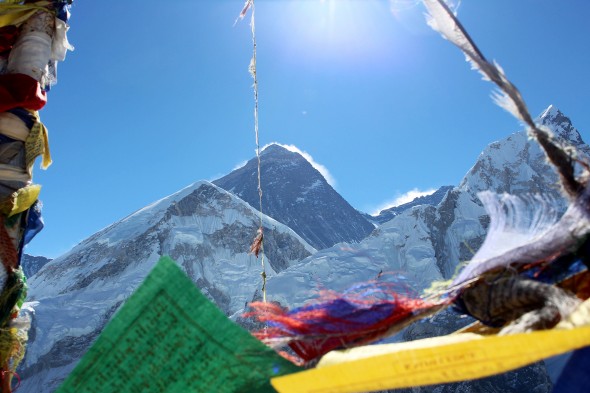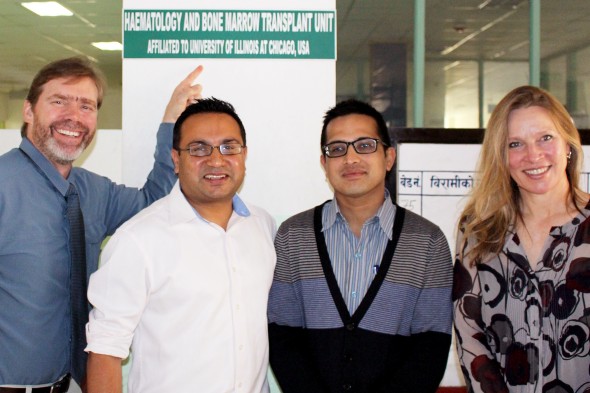Helping hands to Nepal after devastating earthquake

Mount Everest Base Camp, where staff from the UIC Center for Global Health led a wilderness medicine camp last month. They returned to Chicago a week before the earthquake. Photo: UIC Center for Global Health
To donate to Nepal relief
Project CURE
Binaytara Foundation
Nabin Kafle left his hometown of Kathmandu, Nepal, three years ago to study at UIC.
When he heard news of the devastating earthquake that struck Nepal April 25, he immediately tried to contact his family. He couldn’t reach them for a few hours.

Engineering graduate student Nabin Kafle returns to his native Nepal next week to help his family, bringing donations from classmates and staff.
“I was very worried, but my parents and brothers and sisters were fine,” said Kafle, a doctoral student in civil engineering. “But houses were destroyed in the community. People were living outside for days in fear of entering their homes because of the aftershocks.”
The 7.8 magnitude earthquake, which struck near the capital city, killed about 7,000 people and injured more than 14,000. From 7,600 miles away, Kafle felt the loss his friends and family endured.
“Seeing the photos and videos were making me cry — all of the places that I knew so well were destroyed and everything was turned to dust,” he said. “It was very depressing for me. I couldn’t even focus on my classes and research.”
Kafle returns to Kathmandu Monday, staying for a month to visit his family, help where he can and conduct research on humanitarian logistics. With donations he collected from students and employees in the College of Engineering, he purchased medical supplies to bring back with him.
“I want to see what I can do to help,” he said.
Global outreach
Two leaders from the UIC Center for Global Health spent several weeks in Nepal this spring, returning to Chicago a week before the earthquake.
Timothy Erickson, the center’s director, and Valerie Dobiesz, director of education and humanitarian relief, worked with health care leaders on disaster preparedness and emergency medicine plans. They also led a wilderness medicine course at the Mount Everest Base Camp.
“The people of Nepal knew this disaster was inevitable. Every 75 years there has been a major earthquake and it had been over 80 years since the last one hit,” said Erickson, professor of emergency medicine.
“They just don’t have adequate resources to handle a disaster of this magnitude. It’s a very poor country and they don’t have the infrastructure or medical response system in place to manage this. That’s why international assistance is so desperately needed.”

UIC Center for Global Health’s Timothy Erickson, left, and Valerie Dobiesz, right, at the bone marrow transplant unit at Kathmandu Civil Service Hospital.
Faculty members affiliated with the Center for Global Health have been working in Nepal since 2008, Erickson said.
Projects include emergency preparedness and a cancer center/bone marrow transplant program directed by Damiano Rondelli, director of the UI Health blood and marrow transplant program. UIC also has an affiliation with the Kathmandu Civil Service Hospital.
“All of our colleagues and friends in Nepal were safe,” Erickson said. “The hospitals were overwhelmed but functioning. But everyone we know there have friends or family members who were injured or died.”
To donate to Nepal relief efforts, Erickson recommends two organizations: Project CURE and the Binaytara Foundation, a nonprofit started by UIC graduate Binay Shah, a native of Nepal.
“These organizations are very familiar with the needs of the Nepalese people and are making sure the villagers are taking care of,” he said.
It could take up to 15 years to rebuild after the earthquake’s destruction, Erickson said.
“There’s a huge outpouring in the capital city of Kathmandu and that’s terrific, but what’s really needed now is support in those remote villages.
“Access to these small villages is difficult because it’s so mountainous. To reach them, most people have to walk and carry supplies on their back and heads. You can only imagine how difficult that is when everything is in rubble.”
Categories
Topics
disaster relief, earthquake, global health, health care, humanitarian aid, Nepal, volunteerism
